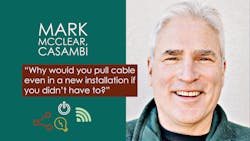New Casambi North American boss wants to take wireless controls to the next level
The new head of North American operations for Finland’s Casambi is truly steeped in an LED chip background, but he is now wearing a different lighting passion on his sleeve — wireless controls.
“I think controls is the next big thing in lighting, and wireless controls is even more so,” Mark McClear told LEDs Magazine recently, following his appointment three weeks ago as Casambi’s general manager for North America. “It’s a natural fit for retrofits and why would you pull cable even in a new installation if you didn’t have to?”
His zeal is understandable, especially considering that when Casambi made the announcement, CEO Kari Mettälä, based back in Espoo outside Helsinki, articulated the heady expectation that “Mark will grow Casambi into the leading U.S. wireless lighting control provider.”
No pressure.
Casambi’s presence has been stronger in Europe, where it claims that more than 3 million nodes are operating with its Bluetooth-based software. At its core, Casambi is a software company. It partners with about 200 companies to provide more than 600 devices including sensors, wall-packs, drivers, switches, and luminaires. Those products not only support controls but, in some instances, also help provide IoT functions, such as tracking assets in buildings, analyzing the use of rooms and space, and providing indoor navigation assistance.
McClear envisions the same sort of presence in North America, and not just because wireless provides a compelling alternative to conventional wired controls such as DALI (Digital Addressable Lighting Interface). Equally, Casambi can liberate users from the wireless control systems that come attached to sales by large luminaire vendors, he maintains.
“Those closed systems tend to lock specifications, limit choices for luminaires, sensor types, and many other features, and reduce real competition on bids,” McClear told LEDs. “I see Casambi as an equalizer here — ‘Wireless Lighting Controls For Everyone.’ And since our system is open, new products can be added all the time, sparking innovation and competition that can benefit everyone.”
Business background
Not long ago, McClear was heading initiatives to sell LEDs to some of the lighting manufacturers that he now regards as closed systems culprits. McClear was president of Seoul Semiconductor Americas for two years from 2017 to 2019 after serving as vice president for a year. In a 10-year stay at Cree, he rose to vice president of global sales for LEDs. His move out of chips began in February 2020, with a two-year stint as chief operating officer of Carlsbad, CA-based circadian and horticultural lighting company BIOS.
Now, in a sense, he will be competing against some of his previous customers.
Working from Casambi’s Atlanta office, McClear will also compete against other independent controls operations, especially those that offer mesh solutions supporting luminaires spread out over wider areas — companies such as Wirepas and those backing the Bluetooth mesh standard. (Casambi offers a mesh scheme, but does not base it on Bluetooth mesh software. Like Wirepas, Casambi communicates device-to-device with Bluetooth radios but meshes them together via their own architectures. All three are different). Thread and Zigbee also factor into the mesh landscape.
“We plan to demonstrate that Casambi is proven, reliable and robust, functional, economical, open to all developers, secure, easy to use, and supported in English from North America,” McClear said, repeating his call for independence from luminaire providers.
MARK HALPER is a contributing editor for LEDs Magazine, and an energy, technology, and business journalist ([email protected]).
For up-to-the-minute LED and SSL updates, why not follow us on Twitter? You’ll find curated content and commentary, as well as information on industry events, webcasts, and surveys on our LinkedIn Company Page and our Facebook page.

Mark Halper | Contributing Editor, LEDs Magazine, and Business/Energy/Technology Journalist
Mark Halper is a freelance business, technology, and science journalist who covers everything from media moguls to subatomic particles. Halper has written from locations around the world for TIME Magazine, Fortune, Forbes, the New York Times, the Financial Times, the Guardian, CBS, Wired, and many others. A US citizen living in Britain, he cut his journalism teeth cutting and pasting copy for an English-language daily newspaper in Mexico City. Halper has a BA in history from Cornell University.





